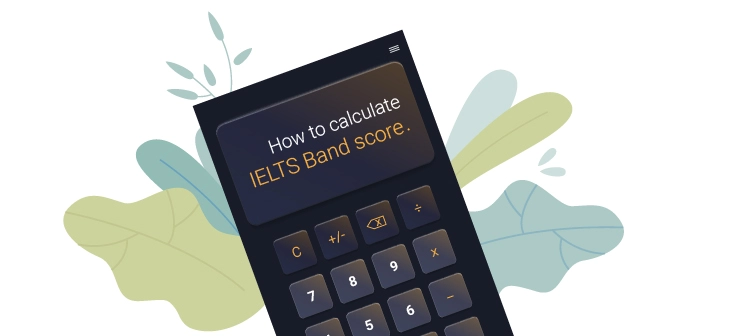
The IELTS (International English Language Testing System) test is a standardised assessment of the English language proficiency for higher education, migration and employment. It evaluates your ability to use English at an advanced level by comparing it with other international standards in language proficiency. Students take up the IELTS exam to achieve admission in universities, work or migrate to countries like the US, UK, Canada, New Zealand, Australia, and many more.
The IELTS Band Score is a number that reflects your ability to communicate in English. It ranges from 0-9, with 9 being the best possible score and 0 being the lowest possible number. Four sections make up your final IELTS test: listening, reading, writing, and speaking.
Each section will have its band scores, which will be added to calculate your overall IELTS test result. In this blog, we will help you better understand the IELTS band score and how each section score constitutes the overall IELTS score projecting the different levels of competence.
After completing your IELTS exam, you will be given a band score between 0-9. The total score comprises the individual scores from each of the four sections. They are weighted equally using a tabular form of band scores.
The difference between the individual scores in each section is not more significant than one point, which means that if you scored higher on a particular area, such as reading or listening, it would only take fewer points to reach the next level of competence. With IELTS Training, you will have a better idea of how IELTS is scored and how you can work towards it.
The overall band scores are calculated to the nearest whole or half band. It is possible to get .5 scores as well. For example, if the final score is not a precise half score or a total score, it is pushed to the nearest whole or half score depending on the most immediate. An overall 6.1 is moved to a band 6, whereas an overall 6.75 is transferred to a band 7.
The IELTS Band Scale represents your English language proficiency on a scale of 0-9. The overall IELTS score of a candidate is the average score of the four sections. The following table will give you a clearer understanding of what each score means:
| BAND SCORE | SKILL LEVEL | DESCRIPTION |
| Band 9 | Expert User |
|
| Band 8 | Very Good User |
|
| Band 7 | Good User |
|
| Band 6 | Competent User |
|
| Band 5 | Modest User |
|
| Band 4 | Limited User |
|
| Band 3 | Extremely Limited User |
|
| Band 2 | Intermediate User |
|
| Band 1 | Non-User |
|
| Band 0 | Did not attempt the test |
|
The overall band scores are calculated by taking the average from listening, reading, writing, and speaking. The score for each component is calculated equally. To gain acceptance in your desired university, you must score a good score as per requirements. For example, to achieve a 7+ band score, you must prepare well in advance and focus on each section separately.
The IELTS band score measures your English language proficiency on a scale of 0-9. It indicates how well you will be able to communicate at work or study in an English speaking country and what level of courses you may be eligible for. Only if you acquire the passing score you can get the admission you dreamed of.
Depending on the number of questions, the raw score is converted to a band score. You must be well aware of the exam pattern. IELTS exam pattern is given in the table below:
| IELTS TEST COMPONENT | DURATION | NUMBER OF QUESTIONS |
| Listening | 30 minutes | 40 questions |
| Reading | 60 minutes | 40 questions |
| Writing | 60 minutes | 2 tasks |
| Speaking | 11 to 14 minutes | 3 part interview conversation |
The candidate will go through 4 sections of recordings in 30 minutes which they will need to answer 40 questions in the additional 10 minutes given to write. Each correct answer will be awarded one mark, and there is no deduction for wrong answers.
The maximum raw score you can achieve is 40 marks, then converted into band scores ranging from 0 to 9.
| RAW SCORE OUT OF 40 | BAND SCORE |
| 38 - 40 | Band 9 |
| 35 | Band 8 |
| 30 | Band 7 |
| 23 | Band 6 |
| 16 | Band 5 |
Enrol now on NIOS Course in Dubai to pursue your education.
The IELTS Reading component consists of 40 questions within 60 minutes. Each correct answer is awarded one mark and then converted on a band scale of 0 to 9. Evaluators grade both Academic Reading and General Reading on the same scale, but the distinction between both is the content and number of correct answers in each.
The Academic reading tests contain texts which feature more difficult vocabulary or more excellent complex style. The difference between Academic and General reading scores are given below:
| RAW SCORE OUT OF 40 |
BAND SCORE | |
Academic Reading Test: |
General Reading Test: |
|
| 38 - 40 | Band 9 | |
| 35 | 38 | Band 8 |
| 30 | 34 | Band 7 |
| 23 | 30 | Band 6 |
| 15 | 23 | Band 5 |
| 12 | 15 | Band 4 |
The writing test assessment comprises two tasks that need to be completed within 60 minutes. The candidate should complete the first task within 20 minutes and the second within the remaining 40 minutes. The section is evaluated based on the following:
The following table explains how IELTS writing scores are considered based on 4 criteria:
|
|
|
|
|
|
|
|
|
|
The speaking test is conducted like a conversation or an interview. Within 11 to 14 minutes, the examiner will ask general questions to begin with and then, based on some topic. It is easy to make mistakes in this section, but with Tips To Get A Good Score in Speaking Test, you can perform well. First, the examiner evaluates the candidate in a 3 part interview conversation under four criteria.
The four criteria are weighted equally on the band score. The description of each criterion for the speaking section is given below:
|
|
|
|
|
|
|
|
To Sum Up
The IELTS band score is a general measure of language proficiency in English. It ranges from 0 to 9. The scores from four sections (listening, reading, writing and speaking) are combined with their average score to find the overall band score. To achieve a good IELTS score, you need to work on all four areas equally. An excellent way to do this would be by taking your time with each section so that it does not suffer because of being rushed or answered incorrectly. If you clearly understand how the evaluators score based on each criterion, you can prepare based on those points and strengthen your weaker sections.
See also : Planning to take your IELTS test in Dubai?.Book your test at an official IELTS test centre. For more details check out our IELTS Exam Booking Page.

DHA, NCLEX
Blessy is an experienced medical instructor who specialises in Prometric courses and NCLEX preparation. She has a wealth of knowledge in healthcare education and is highly skilled in teaching and training healthcare professionals. Her main aim is to support students in passing their Prometric exams and NCLEX certification by providing them with comprehensive and up-to-date study materials, personalised instruction, and hands-on practice exams.
Blessy's teaching approach centers on creating a supportive and engaging learning environment that encourages critical thinking, problem-solving skills, and effective test-taking strategies. She is committed to professional development and keeping up-to-date with the latest trends and advancements in the medical field. As part of her commitment, she regularly attends workshops, conferences, and seminars to enhance her expertise, ensuring that her students receive the most relevant and valuable education.
